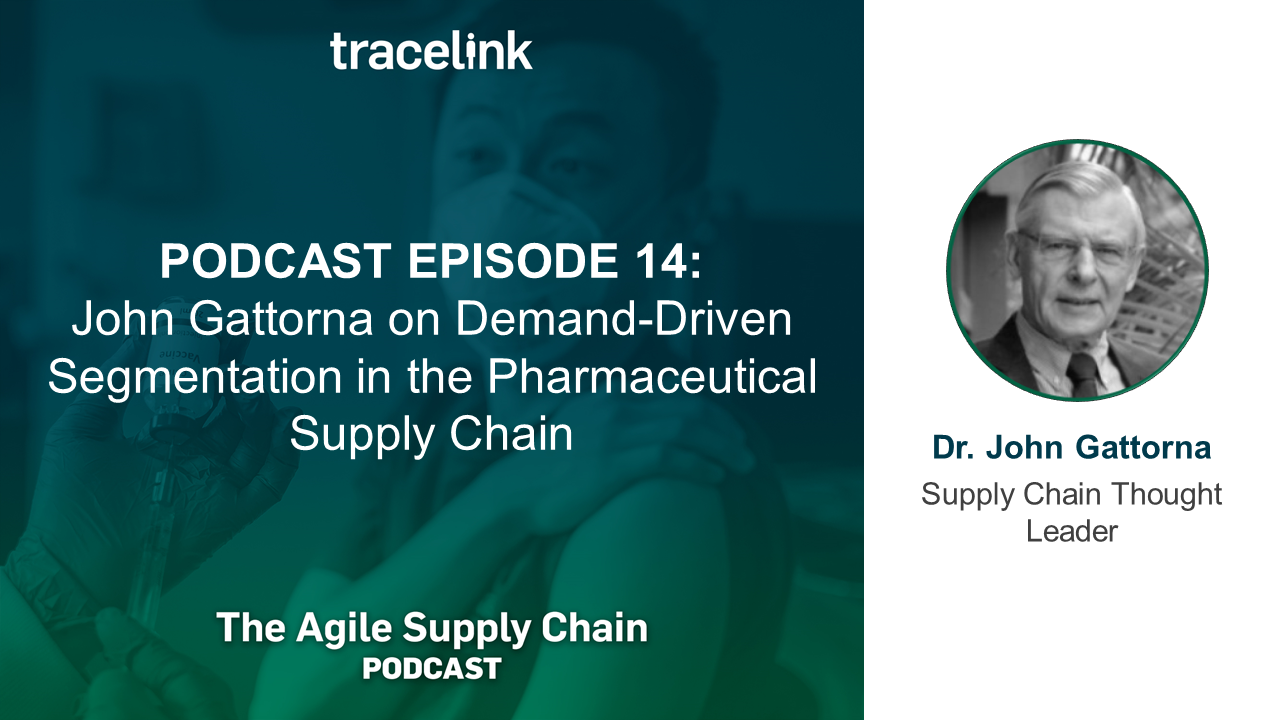Table of contents
Key Takeaways
-
A one-size-fits-all approach to supply chain fails to account for different buying behaviors and different expectations.
- Four or five dominant behavioral segments normally account for 80% of a given market, which can help companies plan their outside-in strategy.
- Demand-driven segmentation is fundamental to understanding the criteria you need to deliver medicine to patients on time, in full, especially for specialty products.

Supply chain thought leader Dr. John Gattorna discusses the fundamental principles of outside-in, demand-driven segmentation for the pharmaceutical supply chain in this episode of The Agile Supply Chain Podcast.
Transcript:
World renowned supply chain thought leader Dr. John Gattorna discusses the fundamental principles of outside‑in, demand‑driven segmentation for the pharmaceutical supply chain on this episode of "The Agile Supply Chain Podcast" with Roddy Martin.
Roddy Martin: John, welcome to this recorded web interview. It's really a privilege to have you. You and I have worked a long road together over 20 years. I think what's been very interesting is your outside‑in segmentation model, which we're going to talk a little bit about today, I believe is absolutely ready for the pharmaceutical industry, which has to fundamentally change its operating models.
Welcome to TraceLink’s thought leadership series. Our CEO has given me a really great opportunity to produce almost a 40‑chapter book of the most influential people in supply chain that you would want to talk to and put them in a series of recorded webinars. Just a fantastic opportunity. Welcome. You are an auspicious member and one of the leading chapters.
I'm going to hand it over to you. Introduce yourself. Talk a little bit about how you got to the segmentation model. If you can, and we don't talk about companies unless you absolutely can, but some of the work you've done. We'll have a fireside chat and ask each other questions. Welcome.
Dr. John Gattorna: Thanks Roddy, and great to be one amongst all the illustrious company that you've gathered for this podcast series. Look, I'm an engineer by first degree. I started off in construction, and oil and gas firms, and all sorts of things, but I got a bit segued after a while.
I decided to do an MBI. When I did my MBI in 1974, I was very lucky to meet a guy who came from Canada, a guy called Matt Doctoroff. He was a Fulbright scholar. He was teaching at a university in Melville. He was the one that introduced me to what was called nurse‑based physical distribution management. I got quite interested in this topic.
When I did the minor phases of inventory, the interest became bigger than what I was doing in engineering. I remember one day saying, I think I'm going to switch over and move into this area called distribution management.
I think the best thing to do now is just go back to the bottom of the heap again after eight or nine years of engineering, I'm going to go find a place to go and do a Ph.D.. I looked around the world with Michigan State, Ohio State, Harvard. I came across Cranfield, which appealed to me, in England.
They did work in all sorts of stuff. There was Rolls Royce and aeronautics and so on. They had a good management skill there. Eventually, I went there. I took my wife and two small kids and sat down on a one‑way trip to the UK back in the late '70s.
We ended up staying five years. We could have stayed forever. It was so good. The wonderful thing about Cranfield was that's where I got my first inspiration about thinking about logistics. By that time, we were starting to talk about logistics, very much from a marketing point of view, a customer point of view.
The whole department was geared around that. I spent four years working on my Ph.D. there and doing some teaching. I did a lot of work in the channel strategy area. I studied the UK’s fast‑moving consumer goods industry and used that in my research. I went and spent another year at Oxford where they wanted me to teach. I decided I wouldn't.
Best for me to come back to Australia. We came back in the early '80s. I got back in as an academic, but again, it wasn't like Cranfield. It was too academic. I'm an applied type person. I broke away and decided to start my own business. I started it in the mid '80s and ran up to the mid '90s, for 10 years. I had clients all over the world.
It was in the late '80s I decided to think about, "Look, this logistics field is just so operational. There's no real concepts. There's no formula. It's got no predictive capability. It's all based on experience. There's got to be something here better than this." It had only started in about 1967, that was the first paper that came out of Harvard. There hadn't been a long history, to tell you the truth.
It was longer than marketing, but it was a long, long history. I gathered together a couple of people. A colleague I met, Norman Shawn, joined me. He came from South Africa. He had a Ph.D. looking at the effectiveness of companies when they try to implement strategy and the interface between strategy and culture. That formed the first part of our alignment module. I had the marketing stuff.
We also were interested in leadership. That's how we got that original concept, what we call strategic alignment. It was a business concept. It wasn't initially meant to be for logistics or supply chain. We were just trying to understand what make businesses tick and how can businesses perform better.
Can they perform better if the company aligns its operational strategies with the marketplace and also align the internal subcultures with those strategies so that they can implement the strategies and push them into the marketplace. Of course, underneath all that, that was all driven by the vision and leadership. We started with this concept in 1989. All of that was serendipitous a little bit.
I'm pretty proud that we started back then, a whole 20 years before design thinking. Things started to come out and tell us that what we should be doing is thinking outside in. We were thinking about the marketplace then. We were aware that the whole model at that time hasn't been, as you know, ready for a long time, this one size fits all.
The paradox was that people were trying to find the simple common set of processes and technologies that made life simple to line up with the marketplace. What they didn't understand was the marketplace is made up of customers that had different buying behaviors, different expectations. The assumption with the one‑size‑fits‑all is that everyone's the same.
We started working in the marketplace. There were no books about this. We started to do work in New Zealand, back in Europe. We work with CPOs, with pharmaceutical companies, industrial companies, FMCG companies, the whole shooting match, oil and gas companies. Gradually, over the years, what we did is made the concept of alignment, we filled it in and it made it more granular.
After about five or six years, we can start to see some patterns. We realized that there were, funnily enough, about 16 archetypes that we had been seeing in the marketplace most human beings in terms of the way they tend to buy products and services. We looked at this and said 16 is too many because the implication is that there has to be 16 supply chains hanging off them.
We kept looking and looking and looking. This is all empirical work that's written in my books. The academics, they're pretty upset about this because they're looking for all sorts of other references, but there are no other references. The only references are the work we did. We read a few academic papers, too.
We did one with DHL Taiwan when Stuart was there, which did the research, fixed that up, and then we converted it into an academic paper.
Roddy: John, if I can just draw out a point that you made, which I think is very fundamental. You dissected buying behaviors, came up with 16 characteristic archetypes of those demand‑driven behaviors, and then looked back at the supply chain and said all of those behaviors, when you map them into a matrix, they represent different kinds of supply chains?
John: Yeah, that's right. The problem was that we then realized that you can't go from 1 to 16. It's too many. We kept looking. The next breakthrough was we found that, using a bell‑shaped curve, that four or five dominant segments in any given market normally account for about 80 percent of that market, 80 percent of the demand.
We went for that idea that four or five dominant segments would give us a good enough fit or an alignment to the market to make it a lot better than what we were getting with a one‑size‑fits‑all.
Roddy: John, the one model, the one matrix that I use from your book, I ascribe to the work that you've done, and I think it's particularly relevant to pharmaceuticals, is the one that has demand forecast accuracy and closeness to the customer, in other words, the relationship side.
That really represents the challenge that pharmaceuticals have, is they don't have good demand forecast accuracy because patient data is difficult, it's private, and it's hard to get hold of. Depending on the lifecycle or the lifecycle of the product, it's either a new product and it's untested, or it's an old mature product and the relationships with hospitals and doctors are established.
Of all of your archetypes, that's the one that really resonates in pharmaceuticals. A hospital may see a new product but may not administer it because they don't have enough history with the product. On the other hand, they administer products they know well because they know that they’re always going to be predictable in their outcome.
John: It's a very interesting point you make. If we jump forward to the COVID period, what we had originally articulated was we said there was the calamity of supply chain, the link supply chain, the campaign supply chain for projects, the HR supply chain, and what we call the fully flexible.
When you look at what COVID has allowed me to think through was that there's a parallel universe in here. In a normal world, when I say normal world, volatility at 50, 60, 70 percent in demand, the first four of those supply chains can cover it. Lean and collaborative, campaign, and agile would normally cover the sort of volatility that we are seeing in what I call business as usual.
The fifth supply chain, which we call fully flexible, is the one that you would just implied for a pharmaceutical where it's absolutely designed for either a disaster recovery situation, or when you're launching a completely new product that you don't know anything about, it's very labor‑intense, and you have to get it out in the marketplace and see whether it's going to make it.
What I'm now talking about more recently, we haven't written it because it's so recent, we're talking about the business as usual portfolio or forced by chance, we handle the normal world, and then this other one, fully flexible, it can handle particularly in a pharmaceutical world, the launches, the campaigns, and can also be used in times of extreme disruption.
Roddy: John, one of the emerging spaces and priorities, and yes, it may be in the initial stages of its life, and that's this personalized medicine or cell and gene therapy where you may be making a very expensive treatment for 5 patients or 10 patients. You can't live with that model that says, "We'll just make 300 days with a vendor entry and spread it all around and all the patients will get."
You've got to segment those 10 or 15 patients very, very carefully because there's really critical criteria around getting that product to each of those patients on time, in full, and there can't be any surprises.
If there's one thing that I think your segmentation model points to, and we're going to talk about it on the Credo panel, that is if you've done a reasonable job at segmentation, you're likely to not get blindsided by complete surprises. There will always be surprises, but you're going to be relatively prepared for surprises.
John: We do a lot of analytics as well on demand patterns, and we relate that to what we're hearing in the marketplace.
What it tells you is it gives you those four or five major segments and could be including, as you said, that personalized medicine segment. Once you know that your market is pretty much structured that way, you can reverse‑engineer back and you can hardwire your business to cope with any of those four or five.
Therefore, it doesn't matter where it comes from after that. Whether it comes out of someone is looking for a brand, or someone is looking for low‑cost product, or someone is looking for something on a quick response basis, you've already got inside the business, hardwired the combination of processes, technology, the teams, the KPIs and things.
It's like I explained, it's like having conveyors. It is putting different products or the same product on different conveyors, and they're being delivered differently to those customers at the other end. You don't have to then, when you get something, suddenly decide, "My God. I've got to do something." It gets rid of a lot of that reaction, and therefore reduces the cost to serve.
Roddy: One of the things that we're going to be talking about on that Agile Supply Chain Credo for healthcare, which is very exciting, is that agility, resilience and reliability are absolutely what's needed in the healthcare industry.
If you're on the defense and reacting to disruptive events on the demand side of the supply chain, you'll get it right sometimes, but you're not going to be reliable in building a capability to get patients on time, in full.
In the work that you've done, what would you say are the three big takeaway value points? You worked with a big industrial company who you've probably put them at the top of the pops in terms of their supply chain logistics capabilities. What are the big three takeaways that are compelling for the leaders in these companies to think about segmentation?
John: My view is that if you do adopt segmentation, and by the way, we're not talking here about institutional segmentation, or industry sector segmentation, or segmentation by who's the most profitable or who's the biggest. That language is all our language in the way we describe customers. What we...
Roddy: Sorry to interrupt you, but I'm glad that you make that point. I want to just emphasize that often when I talk to consultants and leaders about segmentation, "Ah, no. We've heard it. We've done segmentation. It's institutional." The point you're making is extremely important.
It's segmentation by way of the outside in analysis of demand and how the business operating model is going to respond to those different behaviors that drive demand. I'm glad you called that out.
John: When we did the work, and we did it all over the world in all sorts of markets for that industrial company that you were referring to, they had different levels of distributors, wholesalers, retailers. They had an emerging market with major contractors for projects. They had panel manufacturers who used to take along their product.
They had a bunch of different, what we call institutional segments, and what we showed to them, it was like a blinding glimpse of the obvious when we showed it to them. Inside each of those, it didn't matter whether it was a wholesale group or the retail group, inside each of those, they were four, five behavioral segments. In other words, not all house servers are the same.
Some are loyal, some are looking at loyal customer liability. Some are looking at making the manufacturer stock the product and getting quick response, and so on. This was the big breakthrough for them that they realized you've got to go to the next level down, the low segment institutions, to understand what the grouping of outside and expectations are of customers.
That was the first thing. Once you do that, that is the final reference for everything you do, Roddy, because once you know there are going to be for or five behavioral segments and you know what the characteristics are, that tells you step by step what sort of operational strategies you need and what sort of internal organization structure and different subcultures you need.
When you get down to the cultural question, what you've got to do is create subcultures inside your business that mirror the subcultures that you see in the marketplace. When we talk about subcultures in the marketplace, we're actually talking about behavioral segmentation. That's just the external culture of the customers is what we call behavioral segmentation.
What we're trying to do is match and group people inside the business to mirror what we're seeing on the outside and then connect them with processes, technologies and things, and get that alignment. That's the key thing. Quite frankly, between 1970s, '80s, '90s and 2000s, there were so many change and transformation projects done, but they were all a disaster.
The reason was, it wasn't that the strategies were not good, it was that the internal cultural capabilities were just not aligned with the strategies that were being pushed into the marketplace. People were resisting doing the right thing. It created all sorts of problems. Not only were there problems on the outside, but you get a lot of problems on the inside.
The only way to get to the bottom of this is keep looking back at your marketplace, then looking inside what you're doing, and testing what you're doing inside against the marketplace all the time.
Roddy: John, your book, "Dynamic Supply Chain Alignment," it's certainly not bedside reading, but it is absolutely a good reference work. Exactly. It's a really good reference work that any supply chain leader should go through.
The last question that I want to tee up, and that is, when do you do segmentation? I'm really aiming at debunking that you do segmentation once a year, and then you put it in the drawer like a supply chain risk management strategy, and you lead it.
Your segmentation analysis is something that you continually need to do and adapt your design of your supply chain because those behaviors will change as products mature, as events take place in the marketplace. Talk to the fact that it's a continual analysis process and it's something that is not a one‑time event.
John: The interesting thing about this, and this is why I don't particularly like programs like NPS and that because they just measure what people's opinions are at a point in time. You can't just run a supply chain network and spend hundreds or millions of dollars on new infrastructure based on some opinion that might change next week.
When we do behavioral segmentation, we're actually getting to the fundamental expectations that customers have that are driven by their values which they are hardwired with. Think about yourself, then you go and buy a car, you've got certain values. When you go to buy a breakfast cereal, you might be a person that likes the branded products and not the stuff that's on deals.
We're all hardwired. Once you do the behavioral segmentation for the first time, it gets you about 80 percent there, in a sense that after that, if you monitor your market and how well your servicing them, you don't find that customers' expectations change much. The only reason that they change a lot is that you get a change in a CEO in a company, say, in a business, the business environment.
That may completely change the buying behavior of a particular company. I remember working with DHL years ago. They had a big contract with one of the banks doing their global work, and the mail room and everything else. There was a new CEO who came in. That was a loyal relationship that was going very well. Then something changed in the dynamics of the buying group inside the bank.
The new CEO said, "No, I'm going to put that out to tender." Immediately, the buying behaviors changed. On the one hand, individual values and expectations don't change, but the situation we find ourselves in can force us to change for short periods. On top of that, there will be permanent change where there's change of personnel in the buying company.
That's why having done it once, and with the industrial company that we all love that we talked about, we've given them the templates and tools. They just keep going around the world. Every couple of years, they cycle around to the markets and take another look at them to see if there've been any shifts.
The same buying behaviors will be there, but the mix of those buying behaviors may change a little bit over time because of the movement of personnel.
Roddy: Fantastic. John, as we close off, I just want to say what a pleasure it's been to have you. What's the one closing thought that you would leave everybody with that listens to this about you have to think of segmentation from the outside in because of...?
John: Because it is the fundamental frame of reference for everything else that you do in your business.
Roddy: In other words, you can't be agile, resilient and responsive if you have no idea what models are driving people's behaviors.
John: You can't, because everything we've done for the last 50 years has been guesswork. We sat inside the business, looked inside out, taken a view of what we think our customers are telling us because we're not doing the right segmentation. Then, we've gone back inside our company and spent a fortune doing stuff. Then we look up, and we find that's not making any difference.
That's why we need a direct link with our customer, which is trying to understand what their expectations are, and then interpret it back from there.
Roddy: As we know in the pharmaceutical industry, it has 85 percent margins, their way of responding to that is, "We'll just have 300 days' worth of inventory, then you don't have to segment." We all know that that won't work in the future.
John: Not when you get products that are going to be worth two or three hundred thousand dollars. You have all fancy things and treatments and things of that nature.
Roddy: Exactly. John, thank you very much for your insights. We really appreciate it. It's been an absolute pleasure having you.
John: Thanks, Roddy. My pleasure.
Return to: The Patient-Driven Supply Network






